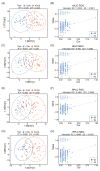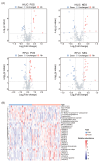Metabolomic Analysis of Follicular Fluid in Normal-Weight Patients with Polycystic Ovary Syndrome
- PMID: 39200274
- PMCID: PMC11352029
- DOI: 10.3390/biomedicines12081810
Metabolomic Analysis of Follicular Fluid in Normal-Weight Patients with Polycystic Ovary Syndrome
Abstract
Background: This study aimed to examine the differential variations in the metabolic composition of follicular fluid (FF) among normal-weight patients with polycystic ovary syndrome (PCOS) and controls and to identify potential biomarkers that may offer insights into the early identification and management of these patients.
Methods: We collected FF samples from 45 normal-weight women with PCOS and 36 normal-weight controls without PCOS who were undergoing in vitro fertilization-embryo transfer. An untargeted metabolomic study of collected FF from infertile women was performed using high-performance liquid chromatography-tandem spectrometry (LC-MS). The tendency of the two groups to separate was demonstrated through multivariate analysis. Univariate analysis and variable importance in projection were used to screen out differential metabolites. Metabolic pathway analysis was conducted using the Kyoto Encyclopedia of Genes and Genomes (KEGG), and a diagnostic model was established using the random forest algorithm.
Results: The metabolomics analysis revealed an increase in the expression of 23 metabolites and a decrease in that of 10 metabolites in the FF of normal-weight women with PCOS. According to the KEGG pathway analysis, these differential metabolites primarily participated in the metabolism of glycerophospholipids and the biosynthesis of steroid hormones. Based on the biomarker combination of the top 10 metabolites, the area under the curve value was 0.805. The concentrations of prostaglandin E2 in the FF of individuals with PCOS exhibited an inverse association with the proportion of high-quality embryos (p < 0.05).
Conclusions: Our research identified a distinct metabolic profile of the FF from normal-weight women with PCOS. The results offer a broader comprehension of the pathogenesis and advancement of PCOS, and the detected differential metabolites could be potential biomarkers and targets for the treatment of PCOS.
Keywords: LC–MS; follicular fluid; metabolomics; polycystic ovary syndrome; reproductive.
Conflict of interest statement
The authors declare no conflicts of interest.
Figures





Similar articles
-
Follicular fluid lipidomics analysis reveals altered lipid signatures in patients with polycystic ovary syndrome.J Obstet Gynaecol. 2024 Dec;44(1):2378489. doi: 10.1080/01443615.2024.2378489. Epub 2024 Jul 17. J Obstet Gynaecol. 2024. PMID: 39016329
-
Follicular fluid lipidomic profiling reveals potential biomarkers of polycystic ovary syndrome: A pilot study.Front Endocrinol (Lausanne). 2022 Sep 13;13:960274. doi: 10.3389/fendo.2022.960274. eCollection 2022. Front Endocrinol (Lausanne). 2022. PMID: 36176459 Free PMC article.
-
Metabolic alterations associated with polycystic ovary syndrome: A UPLC Q-Exactive based metabolomic study.Clin Chim Acta. 2020 Mar;502:280-286. doi: 10.1016/j.cca.2019.11.016. Epub 2019 Nov 20. Clin Chim Acta. 2020. PMID: 31758934
-
Disturbed Follicular Microenvironment in Polycystic Ovary Syndrome: Relationship to Oocyte Quality and Infertility.Endocrinology. 2024 Feb 20;165(4):bqae023. doi: 10.1210/endocr/bqae023. Endocrinology. 2024. PMID: 38375912 Review.
-
Recent progress in metabolomics for analyzing common infertility conditions that affect ovarian function.Reprod Med Biol. 2024 Sep 30;23(1):e12609. doi: 10.1002/rmb2.12609. eCollection 2024 Jan-Dec. Reprod Med Biol. 2024. PMID: 39351127 Free PMC article. Review.
Cited by
-
The Potential Influence of the Presence of Mycotoxins in Human Follicular Fluid on Reproductive Outcomes.Toxins (Basel). 2024 Nov 25;16(12):509. doi: 10.3390/toxins16120509. Toxins (Basel). 2024. PMID: 39728767 Free PMC article.
-
Mass Spectrometry-Based Untargeted Metabolomics Identifies Distinct Metabolic Signatures in Infertility: A Comparative Analysis of PCOS, POR, and NOR.Reprod Sci. 2025 Jul;32(7):2270-2282. doi: 10.1007/s43032-025-01908-5. Epub 2025 Jun 19. Reprod Sci. 2025. PMID: 40537734 Free PMC article.
References
-
- Teede H.J., Misso M.L., Costello M.F., Dokras A., Laven J., Moran L., Piltonen T., Norman R.J., Int P.N. Recommendations from the international evidence-based guideline for the assessment and management of polycystic ovary syndrome. Hum. Reprod. 2018;33:1602–1618. doi: 10.1093/humrep/dey256. - DOI - PMC - PubMed
-
- Chang J., Azziz R., Legro R., Dewailly D., Franks S., Tarlatzis B.C., Fauser B., Balen A., Bouchard P., Dahlgren E., et al. Revised 2003 consensus on diagnostic criteria and long-term health risks related to polycystic ovary syndrome. Fertil. Steril. 2004;81:19–25. - PubMed
Grants and funding
- 81771618/the National Natural Science Foundation of China
- 81971356/the National Natural Science Foundation of China
- 2022BCA042/the Key Research & Developmental Program of Hubei Province
- 2016YFC1000600/the National Key Research and Development Program of China
- 2018YFC1002804/the National Key Research and Development Program of China
LinkOut - more resources
Full Text Sources

